|
Implementing Strategies and Plans |
|
| 7.1 Chapter Overview |
Chapter 7 represents the third step in the ramp management decision-making process. This chapter builds off the previous two steps discussed in depth in Chapters 5 and 6 by addressing the various issues and activities associated with the implementation of ramp management strategies and plans. This includes activities that occur before, during, and immediately after the period in which strategies are physically deployed and operated. A firm understanding of these issues and activities will help agencies successfully implement ramp management strategies developed and selected using the process outlined in Chapter 6.
Implementing ramp management strategies and plans is a delicate process that must be completed well the first time to ensure success. If not carefully planned, ramp management strategies, like any other transportation investment, can ultimately fail. As a result, transportation and ramp management investments may be viewed unfavorably by the public, which in turn makes it difficult to secure the support and funding needed to maintain and improve implemented strategies. Therefore, considerable time and effort is often spent on deciding how strategies will be implemented well before strategies are physically deployed and first introduced to the public. Included in this effort are various steps, executed both before and after the strategies are implemented, that are intended to make implementation more successful. Examples of these steps include public outreach and inter-agency coordination. This effort is also continued beyond initial operation to confirm that strategies are performing as expected and producing expected benefits.
Chapter 7 Objectives:
- Objective 1: Identify the importance and reasons for phasing ramp management projects.
- Objective 2: Understand the importance of public information campaigns with respect to implementing strategies and plans.
- Objective 3: Provide and discuss techniques for disseminating information to the public, agencies and individuals within the agency implementing a ramp management strategy.
- Objective 4: Identify typical agencies affected by the ramp management strategy implementations.
- Objective 5: Understand the role agreements, policies and procedures have in fostering strategy implementation.
- Objective 6: Understand the need and importance of testing ramp management equipment and the other procedures for starting a ramp management program.
The major aspects of project implementation and their approximate timeframe in relation to other implementation activities are captured in Figure 7‑1. Each activity shown in Figure 7‑1 is described in the major sections of this chapter, with the section number of the activity shown in parentheses. The order in which the activity is shown in the figure is a general representation of the relative timing of the various activities, and is only presented to give a general idea of when activities occur. The true time frame for when activities occur is dependent on the type of strategy being implemented and the scope of the effort. For instance, a major, region-wide ramp metering project might have a project start date three to five years before ramp meters are turned on. In contrast, a minor ramp metering project that will deploy just a few ramp meters in a corridor that already has metering may have a project start date approximately one year before meters are turned on for the first time.
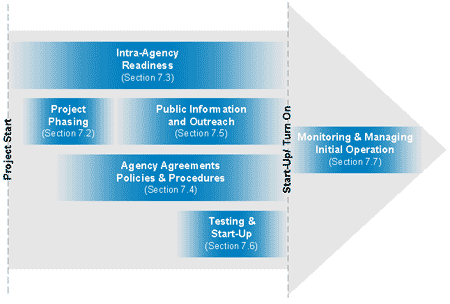
Figure 7-1 : General Activities and Timeline for Ramp Management Strategy Implementation
|
| 7.2 Project Phasing |
The first step to the effective implementation of ramp management strategies is to create a plan that defines the timeframe for when individual projects in the ramp management plan will be phased in. Even if all the funding desired is available, phasing for all but the simplest ramp management plan is important. Ramp management strategies should be phased for the following reasons:
- Allows the agency to become familiar with, and gain an understanding of, ramp management strategies in small steps.
- Allows adjustments in approach as elements are implemented.
- Allows public outreach and inter-agency coordination to be sized in a way that best suits the resources available. Undertaking an outreach and coordination effort that encompasses a large portion of a metropolitan area with many agencies will stretch both the public information office and traffic operations staff thin.
- Can account for the availability of staff to physically deploy strategies, and whether or not they have the capabilities to manage and deploy strategies in a cost-effective manner (see Section 7.3.3). The decision to deploy ramp management strategies without regard to staffing levels and capabilities may significantly delay implementation and erode potential short-term benefits.
- Allows better use of available funding. It is often not possible to have the funds available to implement the entire plan in one project.
An effective phasing plan is one that seeks to deploy ramp management strategies with the available funds in a manner that best suits the experience of the agency, considers the political situation in the area, and maximizes benefits in the short term. This is accomplished by first deploying ramp management strategies at the following locations:
- Where they will produce the most benefit.
- Where the planned deployment of ramp meters is achievable and manageable.
- Where the strategy will be most favorably viewed (it is important to consider whether the strategy is likely to be controversial or require substantial outreach efforts).
For instance, locations where there is a severe safety problem may be targeted first. If this is the first implementation of the strategy, it is important that the local agencies, elected officials, and public are either neutral or in favor of the strategy. This is important so the first implementation can be implemented without major opposition. The next step is to determine a logical segment of the envisioned system to implement.
Using an example of a region that wants to implement system-wide traffic-responsive ramp metering on numerous freeway corridors, the agency might first consider locations where there is historically a high prevalence of rear-end or sideswipe collisions at or upstream of ramp merge points. The geographic extent of the problem in the relevant corridor should then be revisited (see Chapter 6) to make sure there is a logical implementation phase. Metering at isolated ramps should only be deployed if the problems are isolated and if metering these isolated ramps will sufficiently mitigate the problem without unacceptable impacts, such as traffic diversion or unacceptable queues. In many cases, metering only one ramp will not be the best implementation phase. Generally, a more reasonable plan is to phase the implementation in logical groupings of ramps, such as those between major bottlenecks. In some cases, there may be a ramp in a group of metered ramps that is not metered. This is usually the case if the ramp enters the freeway into an add lane, there is a bottleneck immediately upstream of the ramp, and the freeway downstream can absorb the ramp volumes without causing a problem.
Future phases will add additional groups of ramps with the ramp management strategy deployed until the full deployment, as envisioned in the ramp metering plan, can be completed. Additional phases should follow the same logic as the first phase: selecting locations with the greatest potential for benefit in areas where strategies can be most readily implemented, then selecting a logical grouping of ramps on which to implement the strategy.
If funding is available to support the implementation of all ramp meters to be implemented, it may be beneficial to install all the equipment needed at that time. However, implementing the strategy (for example turning on the ramp meters) in a phased approach should still be considered. Funding is only one of the reasons mentioned previously for phasing in a ramp management strategy.
Ramp metering lends itself to this type of construction/installation and implementation/turn-on phasing quite well. If other construction projects are being planned for an area that is planned for metering, it is often a good idea to install as much of the infrastructure needed for ramp metering as possible. Conduit, wiring, cabinets, detectors, communication media, and controllers can all be installed well in advance of the meter being turned on. In fact, if a central system already exists, getting detection in the field as early as possible will help in deciding the most appropriate strategy, determining appropriate performance measures, and collecting performance data before implementation for the evaluation of the system.
If the ramp meters won’t be turned on for a considerable length of time (e.g., many months to over a year) after the infrastructure for some of the ramps will be installed, consideration should be given to not installing the signal heads until shortly before turn-on will occur. Signal heads may be knocked down by errant drivers and the appearance of signal heads well in advance of signal turn-on, even if carefully planned and intended, may give the impression of severe project delays, wasted public funds, and inefficient management.
In any event, the installation of equipment may be best accomplished and most cost effective by finding opportunities to include it as part of other projects, but this should not affect the phasing decisions for final implementation of the strategy. |
| |
| 7.3 Intra-Agency Readiness |
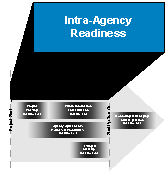 Agencies preparing to implement ramp management strategies should take all the necessary steps to ensure that strategies can be implemented successfully. This includes public outreach efforts and, just as important, intra-agency communication and coordination. Agencies should communicate the goals and objectives of ramp management strategies, as well as the benefits of these strategies, to personnel at all levels within the agency, beginning first with upper management. In doing so, employees will take on the role of ambassadors for ramp management strategies and can speak intelligently about aspects pertaining to the selected ramp management strategies when called upon by outside parties. Despite its importance, in-reach activities only represent the foundation for total intra-agency readiness. Agencies preparing to implement ramp management strategies should take all the necessary steps to ensure that strategies can be implemented successfully. This includes public outreach efforts and, just as important, intra-agency communication and coordination. Agencies should communicate the goals and objectives of ramp management strategies, as well as the benefits of these strategies, to personnel at all levels within the agency, beginning first with upper management. In doing so, employees will take on the role of ambassadors for ramp management strategies and can speak intelligently about aspects pertaining to the selected ramp management strategies when called upon by outside parties. Despite its importance, in-reach activities only represent the foundation for total intra-agency readiness.
Ramp management strategies should not be implemented until agencies are ready to implement, operate, and maintain selected strategies. Implementing the selected strategies requires planning to ensure that the needs of the agency and the public will be met. |
| 7.3.1 Systems and Software Implementation |
|
|
Unlike other ramp management strategies, ramp metering requires that agencies deploy systems and software before metering operations can begin. Other ramp management strategies (e.g., ramp closures, special-use treatments, and ramp terminal treatments) may not be automated processes but rather predominantly fixed or manual activities not requiring computer systems and software. However, some implementations of these other strategies may require computer systems and software. For example, ramp closures may include an automated system of dynamic message signing (DMS) when the ramp is closed, or may include automated or partially automated gate operation that requires computer systems and software. Special-use treatments may also include DMS or detection systems that require computer systems and software. Ramp terminal treatments may also include DMS or new signal system features that will require computer systems and software.
This section will use ramp metering to illustrate the considerations needed when implementing systems and software. However, this discussion may also be relevant to any of the other strategies, depending on the specifics of the strategy and how it will be implemented.
Ramp meter instrumentation (loops, signals, signs, controllers, etc.) need to be installed well in advance of when ramp metering is slated to begin. Likewise, software that is used to establish communications in the field and that allow operators to monitor and control systems need to be developed or procured and tested before implementation can take place.
Systems
Systems installed for ramp management should be developed with a systems engineering approach. There are several references available for information on systems engineering, but readers of this document should first refer to the FHWA’s Freeway Management and Operations Handbook (FMOH), where the systems engineering process as it relates to freeway management is covered (Chapters 3 and 14).[1] This section will only provide a high-level summary of the systems engineering approach.
The FMOH uses the following definition of systems engineering:
“Systems engineering is the process by which we build quality into complex systems. It uses a set of management and technical tools to analyze problems and provide structure to projects involving system development. It focuses on ensuring that requirements are adequately defined early in the process and that the system built satisfies all defined requirements. It ensures that systems are robust yet sufficiently flexible to meet a reasonable set of changing needs during the system’s life. It helps manage projects to their cost and schedule constraints and keeps realism in project cost and schedule estimates.”
The FMOH points out that systems engineering helps accomplish four key activities that impact a project’s success:
- Identify and evaluate alternatives.
- Manage uncertainty and risk in our systems.
- Design quality into our systems.
- Handle program management issues that arise.
Key components of the systems engineering process are illustrated in Figure 7‑2.
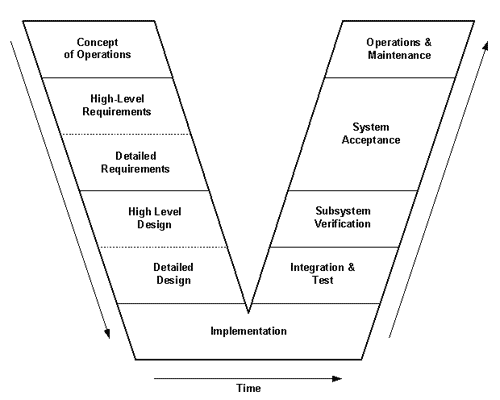
Figure 7‑2 : Systems Engineering Process (“Vee” Diagram)
One of the key concepts in systems engineering is testing. It is critical to make sure all detection, communication, field controller firmware, and central system software is well tested before ramp meters are turned on. Ramp meters and associated equipment need to be installed well in advance of when strategies are slated to take effect. This gives parties responsible for ramp meter implementation time after meters are deployed but before meters are turned on to test each meter to confirm they are working properly. The FMOH discusses testing in Chapters 3, 14, 15, and 16. Readers should refer to these chapters for additional information on system and component testing.
Software
Ramp metering strategies are implemented and operated through a combination of hardware and software in the field and, in most systems, hardware and software at a central location. Centrally-located software links the systems in the field with operators and central computing platforms. Software requirements will vary based on several aspects of the system, some of which include:
- Presence of central control.
- System build out (i.e., is the corridor currently metered, or are metering operations new to the corridor?).
At a minimum, controllers in the field will need software to operate ramp meters and to collect operational data. If a central computer is available, controllers will usually be programmed to transfer data to the central computer where it can be easily processed by operators at a Traffic Management Center (TMC) or similar facility. Software will also be needed to process loop detector data so it can be incorporated into metering algorithms. In this regard, software helps to synthesize the significant amounts of data that are collected.
Software requirements also extend to operator workstations so operators can remotely monitor and control ramp meter operations. Software functions for operator workstations are also established so operators can view ramp meter databases.
Software products that support ramp metering can be commercial-off-the-shelf (COTS) software or contractor-developed products. It is likely that in the implementation of ramp meters, software will need to be developed or existing contractor software modified. The procurement of software (i.e., software development and integration) does not meet the normal linear process that highway or even TMC construction projects follow. Further, it is complicated with ownership and intellectual property rights. With this in mind, practitioners should beware that procuring and implementing software may be a lengthy process that should be undertaken well in advance of when meters will be turned on. There are several references that can provide more detail on software acquisition and ITS procurement. Initially, readers should refer to Chapter 14 of the FMOH.i If additional information is desired, the reader should refer to the FHWA document The Road to Successful ITS Software Acquisition.[2]
Training courses from the National Highway Institute (NHI) are also available for ITS Software Acquisition and ITS Procurement.
Software products that are installed to support ramp meter programs and their documentation should be included in an agency’s configuration management process. A configuration management process is one that manages changes to a system, to ensure that a system is operated as it is intended throughout its design life cycle. Configuration management includes documenting upgrades and modifications that are performed and other attributes related to this work, including the date and reasoning why the work was completed. Configuration management should go beyond just central software and should include central hardware, communications, and field devices. Chapters 3 and 14 of the FMOH provide an introduction to configuration management. |
|
| Before ramp management operations begin, traffic volumes, travel times, and other appropriate performance measures should be collected, modeled, and analyzed to estimate the benefits of implementing the ramp management strategy. Improvements to travel time and travel speeds in a specific corridor, as well as changes in congestion on the mainline and ramps, may be measures of effectiveness that can be used to prioritize locations where equipment will be installed. Depending on the scope of ramp management deployment, this action may need to be completed as much as one year in advance of when the strategy is slated to begin. Chapter 9 discusses evaluation data needs in more detail. |
|
Staff is needed to deploy, operate and maintain the ramp management strategies previously selected in Chapter 6. Strategy implementation requires practitioners to determine the number and type of staff needed to deploy, operate and maintain selected strategies. Implementation also requires that managers allow enough time for the hiring and training of new staff needed. Chapter 4 discussed staffing in general for ramp management. This section builds on the concepts presented there. The reader may wish to refer to Chapter 4 as they read this section.
Ramp metering, as well as other ramp management strategies, requires proper operations software and field equipment (e.g., signals, detectors, and controllers). When these devices fail, ramp strategies can no longer be operated correctly and should not be used again until problems are fixed. To ensure devices can be fixed in a timely manner, properly trained staff should be available to resolve issues in a timely manner.
Despite the type of ramp management strategy implemented, staff are needed to perform routine maintenance activities on devices installed at the ramp, to minimize the likelihood of device failure and to troubleshoot field equipment if it does fail. Staff are also needed to manually close ramps when barriers and gates are not automated. Staffing needs, however, vary by type of closure.
Contractors may be hired on a full-time or part-time basis to satisfy or supplement staffing needs, both for maintenance and operations. Contractors can be used to supplement agency staff or can be used to provide all of the maintenance or operations staff needed. Many combinations of agency and contractor staffing are possible. Agencies should carefully consider the advantages and disadvantages of various staffing options and select the ones that best fit the needs and budget constraints of their respective agency. |
| 7.4 Agency Agreements, Policies and Procedures |
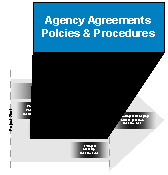 Before ramp management strategies can be implemented, departmental and inter-agency policies are needed to dictate if and how ramp management strategies can be implemented. An assessment of local, county, state and federal laws, regulations, and policies should be reviewed to determine if additional policies are needed and to assure that the planned strategies fit within the existing legal and policy framework for the local area (see the discussion in Chapter 3.). Agency agreements, policies and procedures may be needed to capture support for ramp management strategies as well as to define agency expectations for how strategies will be designed, implemented, operated, and maintained. Depending on the importance of issues identified, agreements between agencies can be formal memoranda of understanding, less formal letter agreements, or informal handshake agreements. In any case, it is critical that personnel from different agencies as well as personnel from different departments within the agency responsible for ramp strategy implementation coordinate to thoroughly flesh out the details pertaining to proposed ramp management strategy deployments. Before ramp management strategies can be implemented, departmental and inter-agency policies are needed to dictate if and how ramp management strategies can be implemented. An assessment of local, county, state and federal laws, regulations, and policies should be reviewed to determine if additional policies are needed and to assure that the planned strategies fit within the existing legal and policy framework for the local area (see the discussion in Chapter 3.). Agency agreements, policies and procedures may be needed to capture support for ramp management strategies as well as to define agency expectations for how strategies will be designed, implemented, operated, and maintained. Depending on the importance of issues identified, agreements between agencies can be formal memoranda of understanding, less formal letter agreements, or informal handshake agreements. In any case, it is critical that personnel from different agencies as well as personnel from different departments within the agency responsible for ramp strategy implementation coordinate to thoroughly flesh out the details pertaining to proposed ramp management strategy deployments.
The following sub-sections identify several key policies and procedures necessary to design, implement, operate, maintain, and enforce ramp management strategies. Both intra- and inter-agency policies and procedures are described, as well as the policies and procedures that span the two. Section 4.3 of this handbook also includes discussion of the needs for inter- and intra-agency coordination. |
| 7.4.1 Policies and Procedures Internal to Departments of Transportation |
|
|
Ramp management strategies require approval and support from upper management and other department managers before implementation can be seriously considered. Support is needed from upper management to secure the resources needed for implementation (e.g., personnel, contracts to procure and install communications, field equipment, workstations, and servers as well as any construction needed), operation, and maintenance of strategies. In addition, upper management support is needed to ensure that implemented ramp management strategies will remain an integral aspect of regional transportation directives and that ramp management investments can be expanded to other areas of need, if appropriate. Input from managers of other departments is needed to verify that ramp management strategies fit into current operations and can be seamlessly integrated. Managers of other departments may also identify implementation challenges associated with selected strategies, which can be resolved before strategies are implemented. |
| 7.4.2 Inter-Agency Coordination, Policies, and Procedures |
|
|
As mentioned in Section 4.3, the implementation of ramp management strategies requires coordination among agencies to establish region-wide policies that guide how strategies are implemented and how associated issues are resolved. Coordination needs to continue beyond the planning stages into the operations stages of ramp management. Several types of agencies with differing agendas will likely be involved with or affected by the operation of ramp management strategies, therefore, policies should be drafted to ensure equity among motorists and agencies across jurisdictional borders. For instance, the state Department of Transportation (DOT) or other agency implementing ramp meters will be doing so to improve operations on the freeway. However, the impacts of ramp metering may expand beyond the freeway to local arterials, increasing the traffic demand on the arterial as well as introducing other unwanted impacts (e.g., reduced safety, increased emissions, increased fuel consumption). Without local agency support, continued operation of ramp management strategies may be problematic. It is important to continue the coordination that was established during the planning stages throughout the life cycle of ramp management strategies. Policies and operational procedures should be revisited and modified if needed to make sure that agency needs continue to be met. Hardware, software, or field modifications may need to be made as well.
Enforcement Agencies
Continued coordination needs to occur between the agency implementing ramp management strategies and local, county, and state enforcement agencies as ramp management strategies are implemented and operated. This should build on the coordination efforts undertaken during the planning phases. Ramp management strategies, such as ramp metering and special-use treatments, require active enforcement to ensure that motorists obey signing, striping, barricades, and ramp signals to maximize the benefits of these investments. Enforcement is particularly important at ramp meter turn-on and the weeks that follow. High visibility of officers during this timeframe will help ensure compliance with the new traffic control devices and reduce driver confusion and the number of crashes attributed to these systems. With this said, however, excessive enforcement may negatively affect driver behavior and directly affect operations on the ramp as officers pull vehicles over on the shoulder. City or state traffic ordinances may need to be amended to ensure that ramp management strategies can be enforced and to dictate penalties for non-compliance. Finally, coordination between enforcement agencies may expedite incident response and clearance.
Ramp metering and special-use treatments are not the only strategy that requires practitioners to coordinate with law enforcement. Coordination may also need to occur when ramps need to be closed due to an emergency, or when severe weather conditions threaten the safety of motorists. In these situations, coordination with law enforcement is needed to restrict access to ramps that lead to roadways where problems are located (e.g., freeways, and roadways adjacent to freeways).
Local and County Traffic Operations
Where applicable, agencies responsible for the implementation of ramp management strategies must also actively coordinate with municipal and county traffic operations departments to ensure that ramp management operations fit well with arterial operations. During the planning and implementation phases, coordination focused on the selection, implementation, and design of ramp management strategies. Memoranda of understanding (MOU) may have been drafted during the planning or implementation phases. If not, they should be considered early in the operational phase. Multi-agency MOUs will show region-wide commitments to ramp management strategies as a congestion mitigation strategy. It is important that agreements consider agency roles and responsibilities, including how traffic signals near metered ramps are operated. MOUs should also include provisions on data sharing, especially if control strategies like ramp metering will interconnect with the traffic signal system and other traffic management elements (e.g., closed-circuit television) operated by either the DOT or local agency.
Local Transit Authority
Coordination with transit agencies should occur throughout the life cycle of ramp management strategies. During the planning and strategy selection stages, decisions were made to either minimize the impact on or enhance transit operations. After strategies are implemented, coordination with the transit agencies involved should include reviewing the operation of the ramp management strategies to make sure impacts to transit are acceptable or to see how transit operations can be further improved. |
| 7.5 Public Information and Outreach |
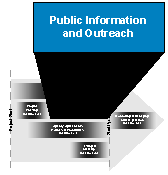 As mentioned in Chapter 6, public support and understanding of ramp management strategies are critical to ensure that strategies successfully meet their objectives. The goal of any public information campaign should seek to lay the foundation needed to build consensus and understanding of strategies proposed for implementation. As mentioned in Chapter 6, public support and understanding of ramp management strategies are critical to ensure that strategies successfully meet their objectives. The goal of any public information campaign should seek to lay the foundation needed to build consensus and understanding of strategies proposed for implementation.
Without a public information and outreach campaign, public or agency opposition to the implementation of ramp management strategies may pose a challenge that can significantly delay or eliminate their implementation. Considerable time should be spent on planning and selecting strategies, otherwise delays may lead to significant and unexpected cost expenditures. In severe cases, public opposition may force agencies to cease the implementation of certain strategies, resulting in wasted effort, inefficient use of limited funds and resources, and perhaps harm to the effectiveness and credibility of the agencies involved. Due to these potentially severe impacts, agencies responsible for the implementation of ramp management strategies should be proactive in their public information and outreach efforts, and they should actively market the reasons for and benefits of proposed ramp strategies.
Agencies should seek to inform the public, local agencies, and the media at various points during the planning, design, and implementation phases of projects to keep these groups abreast of project progress and to solicit information needed to support subsequent project activities. Agencies should also undertake internal efforts to inform personnel at various levels within their organization of the reasons that ramp management strategies are needed, the benefits they provide, and the timeline for their implementation. In-reach efforts will not only ensure common understanding among personnel, but also provide beneficial media through which ramp management knowledge can be promoted and disseminated to outside groups. Finally, preparations should be made to accommodate questions and concerns likely to be posed by the public after strategies are set in place and become operational.
Public information campaigns are also important from the aspect of obtaining public input. Public input is needed and valuable in evaluating and selecting locations to address with ramp management and what ramp management strategies to implement at those locations. Public input is also helpful in establishing program goals and objectives.
The size and scope of the public outreach effort should be commensurate with the size and scope of the ramp management strategy that is selected. In other words, a large public information and outreach campaign that requires significant financial and staff resources would not be appropriate for the implementation of a single ramp meter. Rather, it may be more appropriate for a large-scale deployment of many ramp meters or closures along a corridor or several corridors.
Steps should be taken to deliver information to the public and the media well in advance of when strategies are slated to be rolled out. For certain ramp management strategies such as ramp metering, public information campaigns may need to be set in place anywhere from one to five years before ramp meters are turned on (timing depends on the scale and scope of the project). This time frame is needed to incorporate public and agency comments into the decision-making process and to assure that there is enough time to implement strategies that best address needs. Additionally, public information campaigns are often repeated several times before systems are turned on. This reduces the potential “surprise factor” that, when left unchecked, can lead to public frustration and opposition to proposed strategies. This helps to smooth the implementation of strategies while at the same time achieving public acceptance and compliance.
Information released to the public, local agencies, and the media should be fair and accurate, to reduce the chance that the reliability of released information will be called into question at a later date. |
|
Public information and outreach should target local leaders, motorists, the media, and external agencies thought to have an effect on, or be affected by, ramp management strategy implementation. At a minimum, support and input from these groups are needed to successfully implement ramp management strategies. Information solicited from these groups will be used in part to properly plan how these strategies will be implemented and operated. Public information and outreach should be tailored to the specific needs and concerns of each group affected by ramp management strategy implementation. Likewise, the reasons for and benefits of ramp management strategies need to be expressed in terms that each group can easily understand.
Local Leaders
Local leaders (e.g., elected and appointed officials) can be valuable advocates of or powerful opponents to ramp management strategies. It is important to determine whether local leaders are predisposed to either advocacy or opposition to the proposed strategies, and to develop an outreach program that targets both the advocates and the opponents.
It is important to reach out to advocates to gain their support. It is equally important to reach out to opponents or potential opponents to understand their concerns. Some of these concerns may be ones that can be addressed in the implementation of the strategies. Other concerns may be the products of misconception or misunderstanding that can be lessened by providing accurate information that addresses them.
It is also important to reach out to local leaders to confirm that they have no unresolved issues with the strategies. If no unresolved issues exist, then significant follow through with local leaders would not be necessary and resources could be expended on other aspects of the outreach efforts or other aspects of strategy implementation.
Motorists
 Public information campaigns targeted at motorists, as well as general public groups, should convey the reasons for and expected benefits of ramp management strategies, provide information that explains how strategies work, and dictate what (if any) actions motorists need to take to comply with the new strategies. Motorists’ initial impressions of ramp management strategies may be negative because negative aspects associated with these strategies are more easily observed than their benefits. For example, motorists may tend to focus on the fact that ramps that were once unrestricted, now have meters installed that delay their trips. What motorists often fail to understand is that the negative aspects are in most cases more than completely offset by the improvements to mainline speed, delay, and safety. Therefore, public information campaigns should emphasize how strategies work, the reasons why strategies are being considered, and the benefits likely to be observed. By doing so, motorists’ negative perceptions of ramp management strategies may be mitigated to a greater extent. Public information campaigns targeted at motorists, as well as general public groups, should convey the reasons for and expected benefits of ramp management strategies, provide information that explains how strategies work, and dictate what (if any) actions motorists need to take to comply with the new strategies. Motorists’ initial impressions of ramp management strategies may be negative because negative aspects associated with these strategies are more easily observed than their benefits. For example, motorists may tend to focus on the fact that ramps that were once unrestricted, now have meters installed that delay their trips. What motorists often fail to understand is that the negative aspects are in most cases more than completely offset by the improvements to mainline speed, delay, and safety. Therefore, public information campaigns should emphasize how strategies work, the reasons why strategies are being considered, and the benefits likely to be observed. By doing so, motorists’ negative perceptions of ramp management strategies may be mitigated to a greater extent.
Media
The media can provide practitioners with a means to gain positive support for ramp management strategies from motorists and local leaders. Electronic and print media can be used to express the benefits and reasons for ramp management before and after strategies are deployed. Before ramp meter systems are implemented or expanded, it is important that the local media be notified of program goals, objectives, and benefits well in advance of when meters are expected to be turned on.
Although the media can aid in acquiring public support, the media can also be obstructive if not handled properly. If the benefits of ramp management strategies are oversold and unrealistic, credibility of the implementing agency may be questioned.
Enforcement Agencies
 Outreach activities should extend to local, county, and state law enforcement agencies. Agencies implementing ramp management strategies should seek input from law enforcement agencies as traffic management strategies are being developed, so their perspectives and needs can be incorporated in the selection of the strategies. After the strategies are selected and the implementation phase begins, it is important to provide law enforcement with information on why ramp management strategies are being implemented and why the help of law enforcement is needed. Outreach should also be used to solicit information from law enforcement agencies to determine requirements for successful implementation. These requirements may include: Outreach activities should extend to local, county, and state law enforcement agencies. Agencies implementing ramp management strategies should seek input from law enforcement agencies as traffic management strategies are being developed, so their perspectives and needs can be incorporated in the selection of the strategies. After the strategies are selected and the implementation phase begins, it is important to provide law enforcement with information on why ramp management strategies are being implemented and why the help of law enforcement is needed. Outreach should also be used to solicit information from law enforcement agencies to determine requirements for successful implementation. These requirements may include:
- The extent to which compliance should be enforced.
- Times and conditions when ramp operations should be enforced.
- Locations where law enforcement can monitor and enforce operations and locations where additional monitoring needs to be built.
- Staffing needs for enforcement activities.
- Legal concerns.
Transit
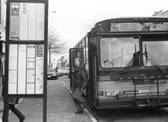 Ramp management strategies such as ramp closure and preferential treatments may affect transit routes and schedules. Because strategies may impact public transit agency operations, these agencies should be included as part of a ramp management outreach campaign. Transit agencies should be included in project discussions, to resolve issues as they arise and to coordinate project activities with transit operations. Ramp management strategies such as ramp closure and preferential treatments may affect transit routes and schedules. Because strategies may impact public transit agency operations, these agencies should be included as part of a ramp management outreach campaign. Transit agencies should be included in project discussions, to resolve issues as they arise and to coordinate project activities with transit operations. |
| 7.5.2 Techniques and Tools |
|
|
Several techniques and tools are available to agencies seeking to solicit input from and disseminate information to the public, outside agencies and/or individuals within an agency. The selection of techniques and tools depends on the intent of the public information campaign or audience targeted.
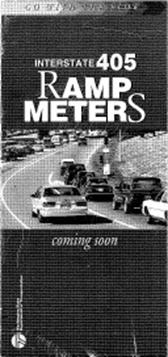 Brochures/Flyers/Newsletters – Brochures, flyers, and/or newsletters may be used to describe ramp management strategies and activities. Brochures, flyers and/or newsletters can be mailed to local residents and business owners located near affected ramps, hand-distributed in locations near ramps, or left for people to take at nearby businesses, public facilities or open house meetings. Mailing lists should be updated to include additional individuals that come forward to provide feedback, to keep them abreast of project activities, timelines and future meetings. Typically, depending on the type of strategy implemented, information contained within the brochure, flyers, or newsletter may pertain to: Brochures/Flyers/Newsletters – Brochures, flyers, and/or newsletters may be used to describe ramp management strategies and activities. Brochures, flyers and/or newsletters can be mailed to local residents and business owners located near affected ramps, hand-distributed in locations near ramps, or left for people to take at nearby businesses, public facilities or open house meetings. Mailing lists should be updated to include additional individuals that come forward to provide feedback, to keep them abreast of project activities, timelines and future meetings. Typically, depending on the type of strategy implemented, information contained within the brochure, flyers, or newsletter may pertain to:
- Description of the strategies to be implemented.
- Expected date and/or time of day that strategies will be in effect.
- Expected benefits and cost effectiveness of strategies.
- Reasons why strategies are being implemented.
- Public information and outreach activities and details.
- Locations where strategies will be implemented.
- Contacts or websites where additional information can be obtained or public comments can be collected.
- Instructions for complying with strategies.
- Websites – The public can be referred to websites specifically set up to provide information on projects where ramp management strategies will be implemented. In Milwaukee, Wisconsin, ramp closure notices are posted to a Wisconsin DOT website. The Milwaukee-area lane and ramp closure website provides the location of the closure, the lanes that are closed, and the duration of the closure.[3] This information provides travelers with advance notification of closures before they embark on a trip, allowing them the opportunity to modify their travel plans accordingly.
- Open House Meetings – Meetings may be held prior to or after major milestones to gather input from and/or disseminate information to the public. Open house meetings are often used to inform the public and local businesses of project progress; to provide a platform for residents, business owners, and motorists to voice their concerns to project staff; and to provide education as to how the strategies will work and how motorists should navigate through them.
To be successful in these pursuits, open house meetings should be held at times during the week when the highest level of participation is possible. Usually, the early evening hours on weekdays (Monday-Thursday) is suitable. Similarly, meetings should be held at a location that is easily accessible to a wide range of individuals, so as to not unintentionally disregard the thoughts and options of a particular group. In most cases, a location near the ramp where strategies will be deployed, which has plenty of parking and is easily accessible via transit is acceptable. In cases where strategies will be implemented in several locations or an entire corridor, several meetings should be arranged at different locations to give ample opportunity for residents and business owners the chance to attend meetings. In preparing for a public meeting, practitioners should leverage resources from within the agency, such as those used for design open houses.
- Inter-Agency Meetings - Meetings in the form of workshops or round table discussions may be held with local agencies to solicit and gather information regarding the implementation of ramp management strategies. Workshops also give agencies the opportunity to coordinate operations and activities and express needs related to these activities. Supplementary meetings may be needed to address lingering issues and to assign priorities.
- Media Releases – Newspapers and other print media can be used to advertise the location, times, and intent of public information meetings. The DOT or other agencies can release written statements or hold press conferences to release information to the media and to answer questions. In some cases, a short video or graphic presentation may be prepared to strengthen understanding of ramp management strategies. Copies of the presentations can be issued to media agencies as requested, reducing the level of effort and time needed to disseminate information and meet with each media outlet.
- Signs – A public notice sign may be posted on or near ramps to advise motorists of impending improvements. If available, the sign should display a phone number that motorists can call to get more information on the impending activity or to provide feedback.
- Automated Messages – Automated messages may be recorded to give callers basic details pertaining to the ramp management strategy. Messages should provide a toll-free number that may be dialed to obtain additional details via an operator or other information source. The public information number should be passed along to other local and regional agencies, so these agencies can direct callers to the toll-free number.
|
| 7.6 Testing and Start-up |
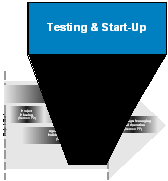 As mentioned in Section 7.3, ramp management strategies should be analyzed for problems and be tested before they are first introduced to the public. Implementation of ramp meters, for example, requires that these devices be tested in advance of when they are first operated to ensure that they are working correctly. This reduces the likelihood that drivers will become confused and/or frustrated. As mentioned in Section 7.3, ramp management strategies should be analyzed for problems and be tested before they are first introduced to the public. Implementation of ramp meters, for example, requires that these devices be tested in advance of when they are first operated to ensure that they are working correctly. This reduces the likelihood that drivers will become confused and/or frustrated.
When testing ramp management strategies, it is good practice to review existing documentation for accuracy. Documentation should be made available to operators to minimize delay in responding to technical problems during start-up. Efforts should be made to update documentation on a periodic basis or when system changes occur. This will ensure that documentation remains up-to-date and confusion does not result when systems require repair or troubleshooting.
Approximately one week before metering or ramp closure takes place, signs indicating the date and time of metering or closure should be placed on selected ramps and also along the mainline. Additionally, the media should be contacted to announce the details of ramp management strategy operation. These actions serve as a final reminder to those that use ramps targeted for strategy deployment.
Before implementing the first ramp meters in an area, it may be advantageous to initially meter ramps at demand (see Section 5.3.3 for a description of metering at demand). This allows motorists to become familiar with ramp meters, while minimizing the impact that meters have on daily travel patterns. This in turn will help facilitate a more positive public perception of ramp meters. |
| 7.7 Monitoring and Managing Initial Operation |
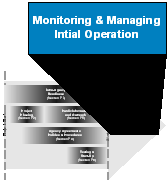 After ramp management strategies are implemented, tested and initially operated, they should be monitored and managed to determine if and how the strategies should be adjusted for optimal performance. System operation should be analyzed on a continual basis and more formal evaluations should be conducted several times within the first year and then annually thereafter. After ramp management strategies are implemented, tested and initially operated, they should be monitored and managed to determine if and how the strategies should be adjusted for optimal performance. System operation should be analyzed on a continual basis and more formal evaluations should be conducted several times within the first year and then annually thereafter.
System operation should be observed in the field and confirmed in the TMC. If problems are observed or reported, adjustments to the strategies, maintenance, or another responsive action should be performed. Likewise, problems reported via other agencies and the public should be investigated, addressed, and corrected.
Evaluations at two weeks, six months, and one year after initial operation often meet the needs to report how the system is doing in the first year of operation. However, more frequent evaluations may be needed, depending on local conditions and whether there was reluctant support for the system. Evaluations should address whether the system is performing as expected and if system goals and objectives are being met.
Public surveys may also be conducted on an annual basis to assess public reaction to ramp meter operations and improvements that have been made. Results of this monitoring and adjustment period should be reported to partner agencies, the media, and the public. Performance monitoring is a key concept for this adjustment period and is discussed in greater detail in Chapter 9.
Monitoring and managing initial operation also includes documenting the software and hardware installed and the control parameter settings used to control systems. Documentation should include system errors, how they were resolved, and any system updates that were incorporated to prevent the errors from occurring in the future. In the initial phases of a ramp management program, documentation will help keep an up-to-date record of activities that may be used to address future hardware and software problems. Documentation should be carried beyond the initial operation of ramp management strategies and should be viewed as a life cycle activity that needs to be continually updated. An in-depth discussion on the operation and maintenance of ramp management strategies is provided in Chapter 8. |
| 7.8 Chapter Summary |
The ramp management strategy or combination of strategies selected in Chapter 6 will not successfully meet defined goals and objectives if they are not implemented correctly. In that regard, ramp management strategy implementation is an activity that must be viewed more broadly than simply deploying equipment in the field. The successful implementation of ramp management strategies, as discussed in this chapter, must begin well in advance of when equipment is physically deployed. The manner in which strategies or elements of the strategy will be deployed must be well thought out and phased according to when the needed resources (e.g., funding, staffing, equipment) will be available. A phased approach to strategy implementation also helps introduce ramp management to the public in small, easy to digest increments. In combination with a proactive and continual public outreach program, this will help capture public support of the strategy or strategies being implemented. A public outreach and information program is also vital in capturing the support of the agencies affected by or involved in the implementation of strategies (e.g., local traffic engineering departments, local businesses, enforcement agencies, and transit).
Before ramp management strategies are physically deployed, they also need to be tested to ensure that they will operate as intended. This reduces the public’s exposure to problems in the field while reducing confusion and opposition to ramp management. After strategies are deployed, they need to be periodically monitored and adjusted if necessary, to ensure that they continue to operate as expected. Detailed discussion on the operation of ramp management strategies in provided in Chapter 8. Chapter 8 also explains procedures for maintaining strategies throughout their designed life cycles.
|
| References |
1. Freeway Management and Operations Handbook. Publication FHWA-OP-04-003. FHWA, U.S. Department of Transportation. September 2003. Available: http://ops.fhwa.dot.gov/freewaymgmt/freeway_mgmt_handbook/index.htm
2. The Road to Successful ITS Software Acquisition. Publication FHWA-JPO-98-035. FHWA, U.S. Department of Transportation. July 1998. Available: https://www.fhwa.dot.gov/tfhrc/safety/pubs/its/architecture/rdsuccessvol1.pdf
3. Travel Information Website. Milwaukee-area Lane and ramp Closure. Wisconsin Department of Transportation. http://www.dot.wisconsin.gov/travel/milwaukee/closures.htm Accessed November 22, 2004.
Continue to Chapter 8 |
|
|
|
 |
|

